1982 Swiss Grand Prix race report
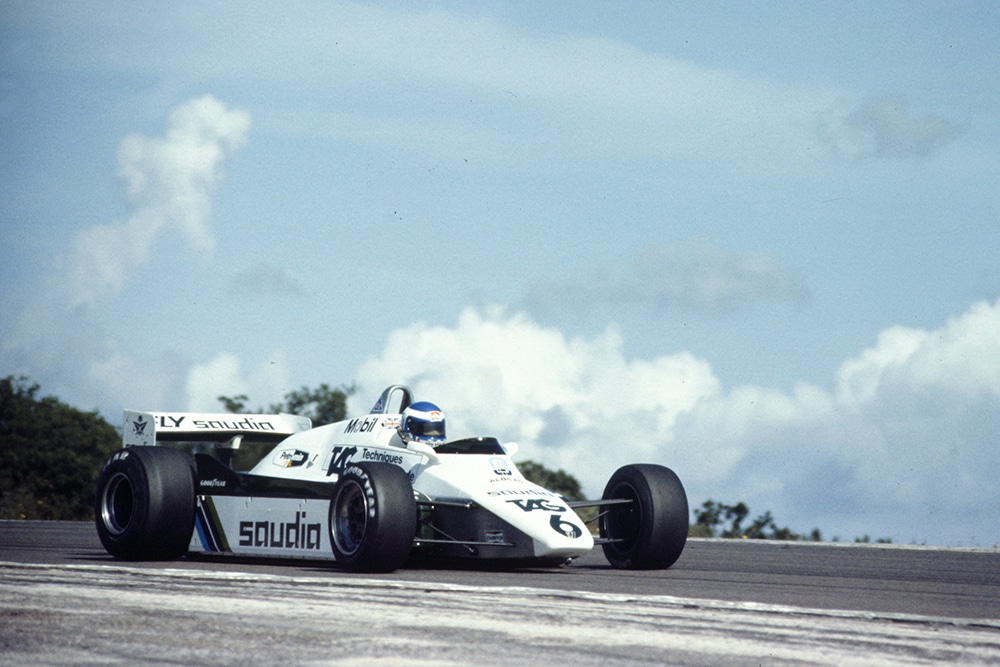
William's Keke Rosberg took a debut win at Dijon-Prenois
Motorsport Images
Another first
Dijon-Prenois, August 29th
THIS has been the season for surprises, with the Spanish Grand Prix not happening and nobody really noticing, a race appearing round the streets of Detroit, and nobody really knowing why, the Dutch Grand Prix suddenly happening when we had all been assured it was off, four Grand Prix races in five weeks, when everyone had previously agreed that there should be at least a week between races and two Grand Prix races in France, though the second one was called the Swiss Grand Prix! Ferrari started the year with the strongest team he has had for many years and by half-way through the season it was decimated and we now had a Grand Prix without a Ferrari on the grid. It has certainly been an odd season.
The Detroit Grand Prix took place by reason of bending all sorts of rules and now we had a Swiss Grand Prix in France without bending any rules, simply because none exist to cover such an arrangement. If we can get Home Rule for Wales we will be able to have a Welsh Grand Prix at Donington Park, or if we can make the Isle of Dogs a Principality it can have its own Grand Prix at Brands Hatch next year, when the British Grand Prix is at Silverstone. If the RAC were as active as some of their European counterparts there is no reason why we should not have three Grand Prix races in England next year.The Automobile Club of Switzerland are not allowed to hold motor racing in Switzerland by reason of a Government Order so they came to an arrangement with the owners of the Dijon-Prenois circuit to hold a race there under the responsibility of the Swiss but ministered to by the French, with some Swiss help. To all intents and purposes it was a second French Grand Prix.
Qualifying
Everything ran to the normal rules, with the normal Formula One entry and after the usual morning sessions of testing and afternoon qualifying sessions, on Friday and Saturday, a grid of twenty-six cars was sorted out, with very little that was unusual about it. Renault dominated the scene, as they so often do, the Brabham-BMWs were nothing like so competitive as they had been in Austria and all the usual people were in the usual places. Lauda was outstandingly quick, the McLaren MP4 being as good here as it was bad in Austria and the Toleman-Harts were not as quick as expected, though they both qualified, which shows some progress from last year. Mansell was on the back of the grid by reason of falling over Henton’s Tyrrell during practice and then not really getting going. They had a bit of a shout-up about the incident and it made a change to know that both drivers knew what the other was saying, even if one has a Brummie accent and the other a Derbyshire accent. That sort of shout-up you can take seriously, in contrast to two “foreigners” trying to have a row without a mutual language, other than poor English. In the Renault pits there was no row at all, rather the opposite, a deathly hush, for Rene Arnoux was known to have agreed to join the Ferrari team for next year.
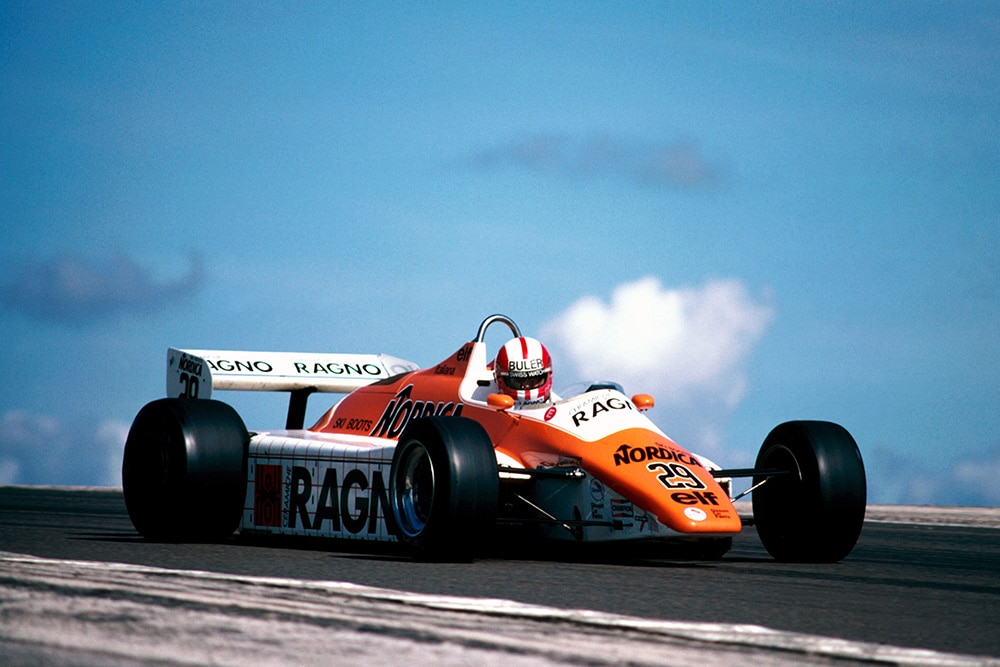
Marc Surer put his Arrows 14th on the grid
© Motorsport Images
Not that Renault wanted to keep him after the disobeying of orders during the real French Grand Prix, but if he is going to the opposition there is no point in letting him take more information with him than is necessary. He did not help matters during Friday morning testing when he crashed RE38B very extensively and had to spend the rest of the time, as well as the race, in the T-car. Luckily, Prost did not need it and Renault did not send back to Paris for a replacement. Prost was fastest on Friday afternoon, and Arnoux was second and they were both so much faster than the rest that it was almost embarrassing. On the second afternoon of qualifying the team opted out officially from using qualifying tyres, and got on with some race preparation testing.
For once the BMW engines were proving reliable but the Brabham chassis were not working too well, there being an imbalance of all the variables which Gordon Murray could not sort out. On the second afternoon both drivers used the super-light T-car to record their times, and Patrese was fastest of the day, but still a long way behind the Renault times of the day before.
With a number of downhill corners that fall away it was not surprising that many of the drivers were whining about “too much understeer”. There would have been something very wrong if they had had too much oversteer. Canard fins on the nose cone were back in fashion, having been gradually discarded in the interest of speed on the straight and unimpeded air-flow to the underneath of the side-pods. Lauda was so satisfied with his Friday performance (fourth place on the grid) that he did not bother to do any practice on Saturday afternoon, and another driver who missed Saturday afternoon was Tambay, but for a very different reason. Since Austria his back had been giving trouble, with trapped nerves, and he could hardly use his right arm.
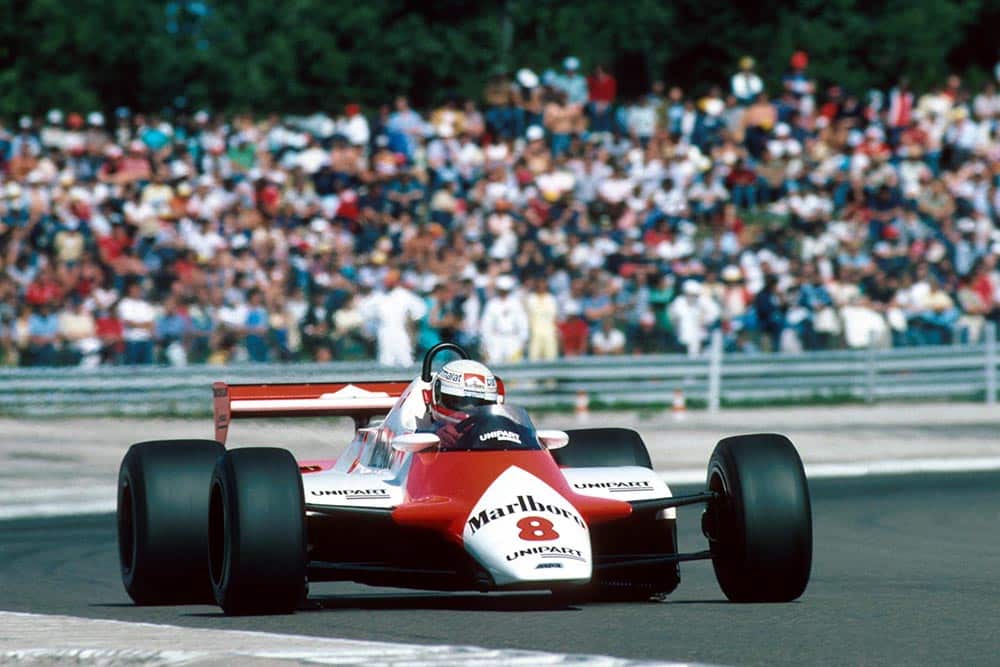
Continuing his comeback for McLaren, Niki Lauda started 4th
Motorsport Images
He made a good time on Friday, considering this, but rested on Saturday as the pain was too much. It did not get any better and he was forced to withdraw from the race on Sunday morning, leaving a blank space on the grid. There was another blank space on the grid when the race started on Sunday afternoon, for the Ensign had engine trouble during the morning warm-up and the engine change took too long and Guerrero missed the assembly procedure and had to start the race from the pit lane after everyone had gone. It did him little good for the engine that had been put in was a tired old nail (it was all the team had left) and it expired within a few laps.
Race
On paper the Renaults were going to run away with this race, but that has been the scene on paper many times this year. The Brabham-BMWs could not match their pace, not even Piquet who was on half a tank of petrol and preparing for the pit-stop routine. Patrese was not even in the picture for he was with a full tank and planning to go through non-stop, providing the BMW engine permitted it. In Austria the Williams team had shown clearly what they have been up to. By a process of trial and error and some calculation and measurement they have come up with a set-up for the FW08 whereby they sacrifice a bit of potential in the early stages of the race in return for having the car in really cracking form in the latter half of the race. It is all tied in with weight-distribution, ride-height, under-car ground-effects, tyre choice and a balance of numerous variables. A car can never be perfect all the time, for conditions and variables must change throughout the race, with petrol being used up, tyres wearing down, brakes wearing out and so on. They have devised a formula for the FW08 whereby it is at its racing best towards the end of the race, and for this they must have a driver who can guarantee to be in a similar state. This they have in Keijo Rosberg, for the stocky little Finn has remarkable durability and can go as hard on the eightieth lap as he can on the first lap, which not many of the drivers can guarantee to do.
While Prost cruised round in the lead, looking totally unassailable, Rosberg was speeding up as the race went on. He was battling with Lauda and they both had a bad time when they came to lap de Cesaris, for the Alfa Romeo driver refused to let them by and caused a lot of ill-feeling among his associates. They got by eventually, and in the closing stages Rosberg was really flying and hauled in the two Renaults in a most impressive manner. By this time Prost was in a bit of trouble with the handling of his Renault as a side-skirt had broken up and the all-important down-force was leaking out. More to the point, he was getting near the end of the life of his Michelins so could do little to stave off the approach of Rosberg and the Williams FW08.
Arnoux had had a long spell in third place while Piquet was making up time before his pit stop, but once the Brabham went in for petrol and tyres, Arnoux was back in a safe second place. As Rosberg was catching the Renaults in the last ten laps of the race it looked as though Arnoux might catch the ailing Prost, but then Arnoux’s fuel injection system went on the blink and after a quick stop for some more petrol he went on again only to have the engine die on him half-way round the next lap. On lap 79, with one to go, Rosberg caught the leading Renault and dived through on the inside of the downhill left-hander on the back of the circuit, in the most beautiful manoeuvre and led the Renault for the remaining lap and a half, much to the consternation of the partisan crowd. Actually he led the Renault for two and a half laps, for after nearly stopping the race at 78 laps the organisers then missed the leader at the end of lap 80 and gave him the chequered flag at 81 laps! The Swiss have not run a full Grand Prix since 1954.
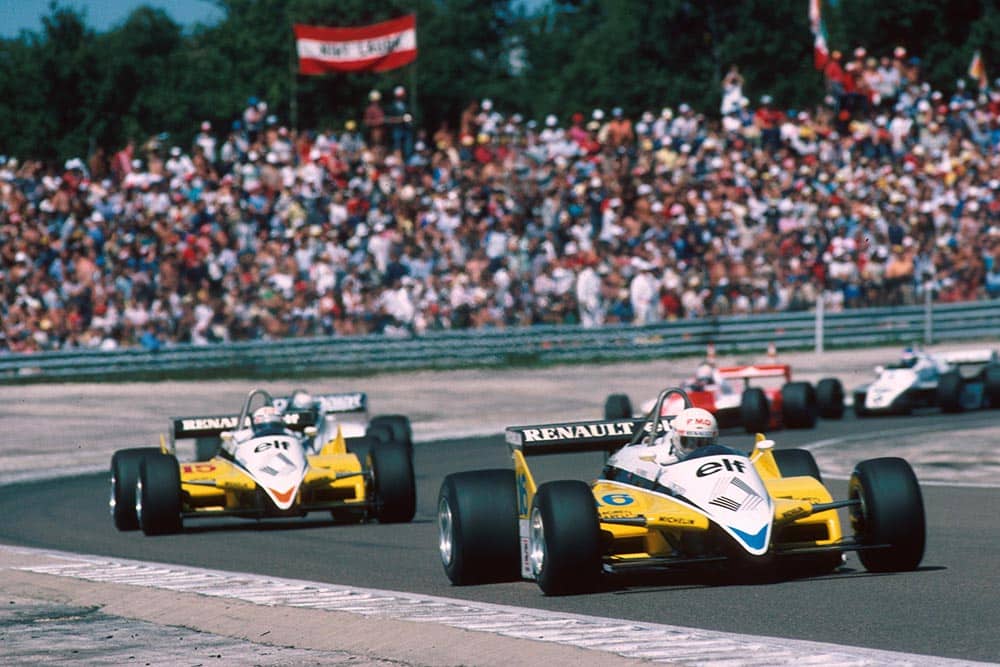
Arnoux leads team-mate Alain Prost on the opening lap
© Motorsport Images
While Prost cruised round in the lead, looking totally unassailable, Rosberg was speeding up as the race went on. He was battling with Lauda and they both had a bad time when they came to lap de Cesaris, for the Alfa Romeo driver refused to let them by and caused a lot of ill-feeling among his associates. They got by eventually, and in the closing stages Rosberg was really flying and hauled in the two Renaults in a most impressive manner. By this time Prost was in a bit of trouble with the handling of his Renault as a side-skirt had broken up and the all-important down-force was leaking out. More to the point, he was getting near the end of the life of his Michelins so could do little to stave off the approach of Rosberg and the Williams FW08.
Arnoux had had a long spell in third place while Piquet was making up time before his pit stop, but once the Brabham went in for petrol and tyres, Arnoux was back in a safe second place. As Rosberg was catching the Renaults in the last ten laps of the race it looked as though Arnoux might catch the ailing Prost, but then Arnoux’s fuel injection system went on the blink and after a quick stop for some more petrol he went on again only to have the engine die on him half-way round the next lap. On lap 79, with one to go, Rosberg caught the leading Renault and dived through on the inside of the downhill left-hander on the back of the circuit, in the most beautiful manoeuvre and led the Renault for the remaining lap and a half, much to the consternation of the partisan crowd. Actually he led the Renault for two and a half laps, for after nearly stopping the race at 78 laps the organisers then missed the leader at the end of lap 80 and gave him the chequered flag at 81 laps! The Swiss have not run a full Grand Prix since 1954.
This was Rosberg’s first Grand Prix win, and was thoroughly deserved, not only because he has looked like winning a race all season, but because he played the Williams tactics to perfection and his driving in the closing laps was a joy to watch. Those drivers who know about these things will tell you that you must drive “ground effect” cars without sliding them, otherwise you wear out the rubbing strips on the side-skirts and “ground effect” will not work if the car is sliding, they will also tell you how you cannot allow the modern tyre to reach break-away point, for cornering power is so high that you would never regain control. Obviously Rosberg has not been listening to them, for he gave a superb exhibition of old-fashioned driving over the limit of adhesion and yet not losing control. In fact, he was in just such a situation when he took the lead from Prost who had run a bit wide. It was stirring stuff. He has now won his first Grand Prix and he won it well, but he is still 18 wins behind Niki Lauda, who came home a shrewd third, only Rosberg, Prost and Lauda completing the full distance.
If heroes are made from non-winners then Nigel Mansell did well to climb up from last place on the grid to eighth place and Piquet finished fourth after making a very quick pit stop for petrol and new tyres, but Patrese’s fifth place was not very inspiring. To say that Watson was not inspiring would be to upset his many followers, but an early charge past a number of lesser lights saw him ruin a side-skirt and he had to make a long pit stop for repairs and new tyres, so he finished well down in 13th place. Daly had all the usual excuses as to why he didn’t beat Rosberg, especially having beaten him by a “gnats” in qualifying and the Talbot-Ligier-Matra lot were their usual shambles, Laffite giving up in disgust at the poor handling of his JS19. Neither of the Tolemans finished, Fabi stopping when the water temperature began to soar and Warwick coming to a stop with a dead engine. The Arrows team produced a brand new design called the A5, which they freely admit is an orange and white Williams FW08 (why copy the wrong car when you can see that the FW08 is a good one to copy) and Marc Surer pedalled it round quite effectively on its debut, but Baldi did not qualify his A4.
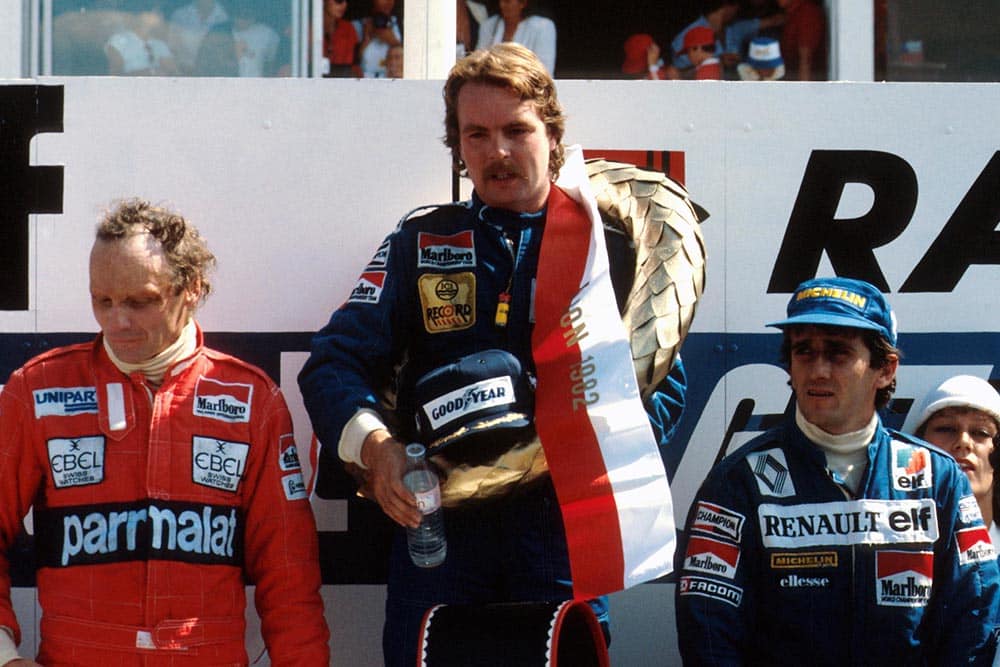
The podium (L to R): Niki Lauda (third); Keke Rosberg (first time winner) Alain Prost in second.
© Motorsport Images
The second French Grand Prix of 1982, called the Swiss Grand Prix, was not an earth-shattering affair and on reflection Renault would have been better off without it, but it put new heart into the Williams team and gave Rosberg the win he’s been deserving all season, for he has been driving his heart out ever since Frank Williams first let him sit in one of his cars. If some of the other drivers drove hard and fast like Rosberg, even with uncompetitive cars, we would have some good racing. But through it all the polished style of the real professional still shines brightly — and who is that, Niki Lauda of course, he is the only standard we have left at the moment. — J.H.
